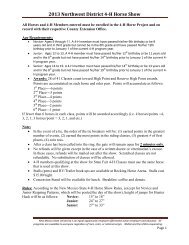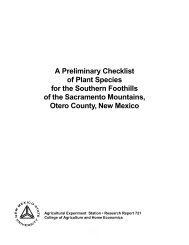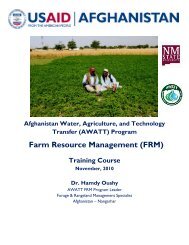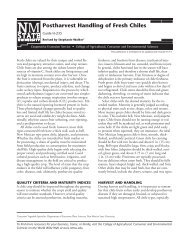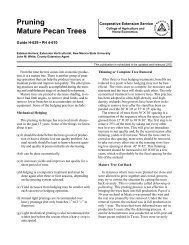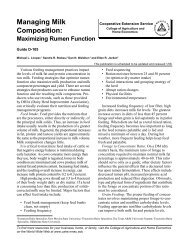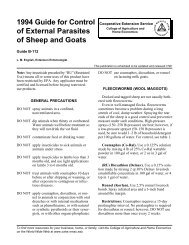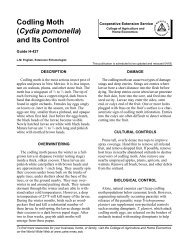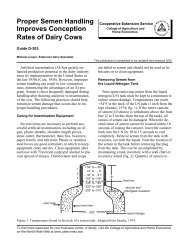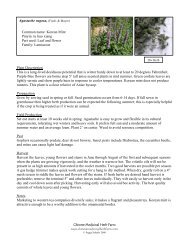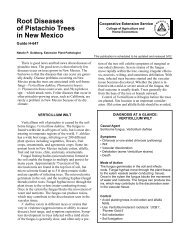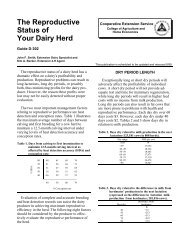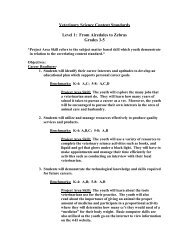PDF Version - NMSU's College of Agriculture and Home Economics ...
PDF Version - NMSU's College of Agriculture and Home Economics ...
PDF Version - NMSU's College of Agriculture and Home Economics ...
Create successful ePaper yourself
Turn your PDF publications into a flip-book with our unique Google optimized e-Paper software.
depth <strong>of</strong> 12 inches. The second foot (12 to 24 inches),<strong>and</strong> deeper depths (>24 inches), <strong>of</strong> soil is <strong>of</strong>ten sampledto improve salinity <strong>and</strong> nitrogen management. Whensampling for soil analysis, it is important to brush aside orremove the surface layer <strong>of</strong> leaves <strong>and</strong> other plant residuesso that analytical results are more representative <strong>of</strong> stablesoil organic matter. The tool <strong>of</strong> choice is a probe that allowseasy soil retrieval without leaving behind a greatlydisturbed area. Some soils are too hard to easily push in aprobe, <strong>and</strong> a hammer is therefore necessary. Some probesare sold with “sliding-hammer” attachments that makesampling much easier. Spades are also a good tool, butyou should limit how much soil you collect in the samplingcontainer. For more information on proper samplingtechniques, please refer to Guide A-114, Test YourSoil (http://aces.nmsu.edu/pubs/_a/a-114.pdf). You canalso view a video on soil sampling at http://www.youtube.com/watch?v=aQMZ-MsYBiQ.WHAT ANALYSES TO REQUESTKey analyses that should be requested from any soiltesting laboratory include• pH,• electrical conductivity (EC),• sodium adsorption ratio (SAR),• organic matter (OM) or soil organic matter (SOM),• inorganic nitrogen (nitrate-N or ammonium-N),• phosphorus (P),• potassium (K),• texture, <strong>and</strong>• micronutrients such as iron (Fe), zinc (Zn),manganese (Mn), <strong>and</strong> copper (Cu).These tests are not unique to New Mexico, butwere used by the NMSU Soil, Water, <strong>and</strong> <strong>Agriculture</strong>Testing (SWAT) laboratory (closed in June 2012) on aroutine basis.There are specific ways the soil must be processedin the lab to obtain accurate results. Soil pH, electricalconductivity, <strong>and</strong> sodium adsorption ratio are determinedfrom a saturated paste extract. Organic matteris determined from a procedure known as the Walkley-Black method (as opposed to “combustion”). Inorganicnitrate-N can be determined by extracting the soil witha potassium chloride solution <strong>and</strong> testing for nitrate-Nafter cadmium reduction. Phosphorus is determinedafter extracting the soil with a solution <strong>of</strong> sodium bicarbonate(Olsen’s procedure) as long as the soil pHis above 7.2. A solution <strong>of</strong> ammonium acetate is usedto extract potassium. Micronutrients are required byplants in small quantities <strong>and</strong> can be evaluated for plantavailability by extracting with a DTPA solution. Othernutrients to consider include sulfate <strong>and</strong> boron. Pleaseconsult Circular 650, Sulfur <strong>and</strong> New Mexico <strong>Agriculture</strong>(http://aces.nmsu.edu/pubs/_circulars/CR-650.pdf),for more information regarding the need for sulfate.Boron is <strong>of</strong>ten sold but seldom needed in New Mexico<strong>and</strong> should only be considered if plants exhibit deficienciesor tissue testing reveals low boron levels within theplant. Boron can be toxic to plants if applied at toogreat a concentration. The amount <strong>of</strong> soil lime presentin the sample is also helpful when considering whatplants to grow.Saturated Paste Extract (Method S – 1.10 inGavlak et al. [2005])In this test method, soil samples are ground <strong>and</strong> passedthrough a 2-mm sieve, then just enough water is addedto make a paste that glistens but does not flow from acup. Soil texture greatly influences the amount <strong>of</strong> waterthat can be added to make it “saturated.” Soils with highamounts <strong>of</strong> clay <strong>of</strong>ten take 24 hours to fully absorb theadded water. Once 24 hours have passed <strong>and</strong> the sampleis saturated, the soil is placed under suction <strong>and</strong> the liquidis removed for further testing. This sample is knownas the saturated paste extract <strong>and</strong> most closely resemblesconditions after an irrigation. Soil pH, EC, <strong>and</strong> SAR(relative amount <strong>of</strong> calcium, magnesium, <strong>and</strong> sodium)are determined from the saturated paste extract.Soil pHSoil pH is a measure <strong>of</strong> the soil’s acidity or basicity (alkalinity).A substance is acidic if the pH is below 7.0<strong>and</strong> alkaline if the pH is above 7.0. A neutral soil has apH <strong>of</strong> 7.0. Technically, soil pH is the negative logarithm<strong>of</strong> the hydrogen ion activity (-log 10(H + )). Commonhousehold items that are acidic include vinegar, cola,<strong>and</strong> c<strong>of</strong>fee, while antacids, detergents, <strong>and</strong> bleach arebasic (alkaline). Ideally, soil pH should be near 6.5 inorder to keep phosphorus in its most available form.Many micronutrients, such as iron <strong>and</strong> zinc, are alsomore available to the plant at a 6.5 soil pH. Other nutrientsfor plant growth are strongly affected by soil pH.Only nitrogen, potassium, <strong>and</strong> sulfur are unaffected bysoil pH. Soil pH in New Mexico is normally between6.5 <strong>and</strong> 8.4. Mountain soils, where more rain occurs,generally have a soil pH below 7.0. Many garden soilsthat have received too much organic matter may alsohave a lower soil pH, but not always. Soil pH should bedetermined from a saturated paste extract (pH s).It is also helpful to know the soil lime content in caseswhere gypsum is recommended as a reclamation tool.Elemental sulfur can be used in place <strong>of</strong> gypsum in situationswhere there is elevated sodium with lime (calciumcarbonate) present in the soil.Guide A-146 • Page 2



